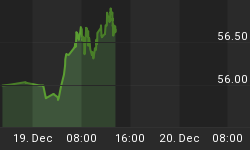We are fast approaching the time when it will become obvious to all that mortally-wounded economies cannot be resuscitated by a massive increase in credit from central banks. Nations that suffer from tremendous capital imbalances, debt capacities and asset bubbles cannot be healed by printing money. Quantitative easing and zero percent interest rates have the ability to provide GDP growth that is merely illusory and ephemeral. This is because it can temporarily levitate equity, real estate and bond prices, which causes an artificial boom in employment and consumption. But the "benefits" of making the cost of money free has its limits, and it also comes with dire consequences.
Further hope in economic growth generated from central banks is quickly fading because the transmission mechanism is now broken. Central banks can print money; but if new assets aren't purchased by private banks there is less of an increase in broader money supply growth. Now that most central banks have set borrowing costs at rock bottom levels there isn't much room to go lower. And it is becoming clear that governments are really good at creating asset bubbles, but woefully inadequate at creating sustainable growth.
For example, the Bank of Japan was fairly successful at creating inflation (YOY CPI up 2.4%), but after more than two years of Abenomics and its attack on the yen, GDP is lower today than in 2012. The growth dynamic isn't much different in China, where GDP growth in 2010 was 5% higher than it is today, according to official government numbers, as the PBOC tries to slowly let the air out of an overwhelming fixed asset bubble.
But now all hopes for central banks to save the world rests on Mario Draghi and the ECB. Two years after promising to do "whatever it takes" to bring down skyrocketing bond yields, the ECB will officially start buying bonds in March. The problem is that Mr. Draghi's well telegraphed move has only served to allow private banks to front run his bid. Therefore, sovereign bond yields are already near zero percent and any artificial benefit derived from lower borrowing costs has already been accounted for. And now these banks, which are saturated with EU debt, are now just waiting until March to say to Mr. Draghi, "sold to you." But these same banks won't be in any rush to make new loans with the ECB's credit or buy additional sovereign debt because the assets in question offer virtually zero profit motive.
The United States has been basking in the afterglow of the Fed's ability to temporarily re-inflate home prices and the pockets of Wall Street bankers. But sorry to say, once again growth on Main Street appears to be chronically illusive. U.S. Q4 2014 GDP growth was less than half of what it was in the prior quarter. And so much for all the drivel about finally achieving, "escape velocity" last year. The 2.4% GDP growth for all of 2014 was still less than the 2.5% growth seen during 2010-the first year out of the Great Recession.
Central banks have destroyed any vestiges of the free market with the primary goal of creating inflation. But with the growth benefits derived from free money (if any) now in the rear view mirror, what do we have to look forward to? Investors have the pleasure of witnessing the massive reversal of bond yields, as the failure of central banks and governments to create viable GDP growth is realized. For instance, the Japanese 10-year Note yield has rallied to 0.46%, from the low of just 0.2% on January 19th of this year. And yields have begun to rise in Europe and the U.S. as well.
The turnaround in global sovereign bond yields is not due to a rise in inflation, nor is it because of an increase in growth. Rather, it is because QE's efficacy has run its course. Therefore, we are left with sovereign yields that must now discount the inflation risk represented by the tremendous increase of central banks' balance sheets, along with the massive increase in IOUs piled up since the Great Recession ended. Most importantly, without the manifestation of this growth promised by central bank money printing, there just isn't any way for sovereign nations to maintain the illusion of solvency. Indeed, since the start of the financial crisis at the end of 2007, total global debt has risen by nearly $60 trillion, which is 286% of GDP, up from 269% seven years ago.
As confidence in central banks to save the world fades, interest rates have started to rise. Rising interest rates is Quantitative Easing in reverse. The increasing debt service payments combined with crumbling asset bubbles will cause spurious global GDP to collapse. On top of this, the Federal Reserve is threatening to raise interest rates into an environment of slowing GDP growth around the world. With the total market cap of U.S. stocks at an incredible 124% of GDP and a world-wide historic bubble in government debt, investors across the globe need to get ready to relive the Great Recession all over again.
Michael Pento produces the weekly podcast "The Mid-week Reality Check", is the President and Founder of Pento Portfolio Strategies and Author of the book "The Coming Bond Market Collapse."















